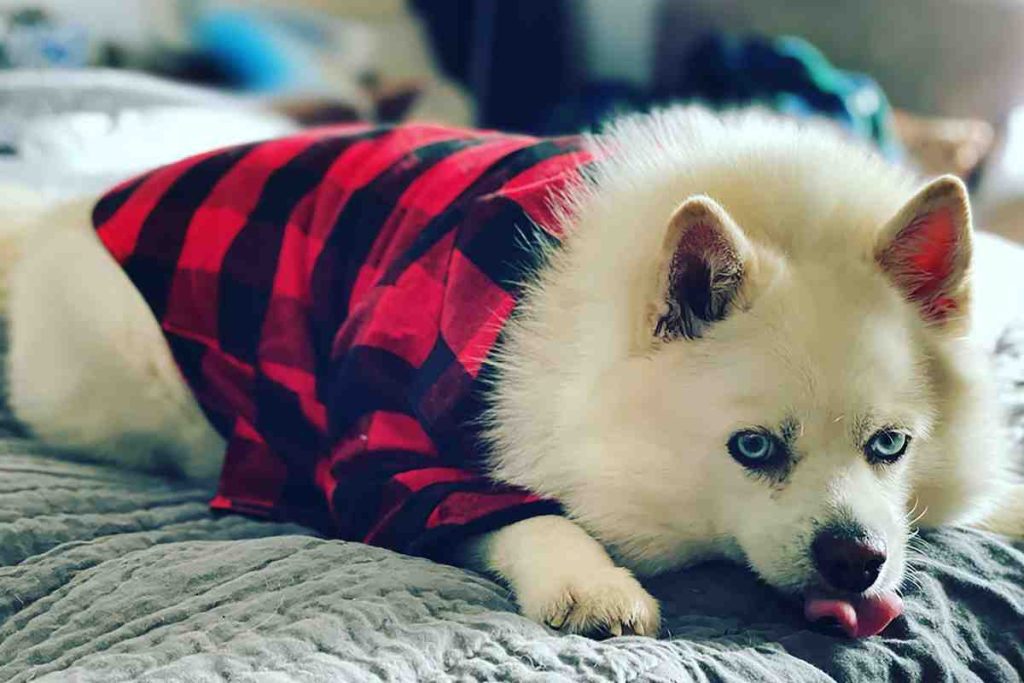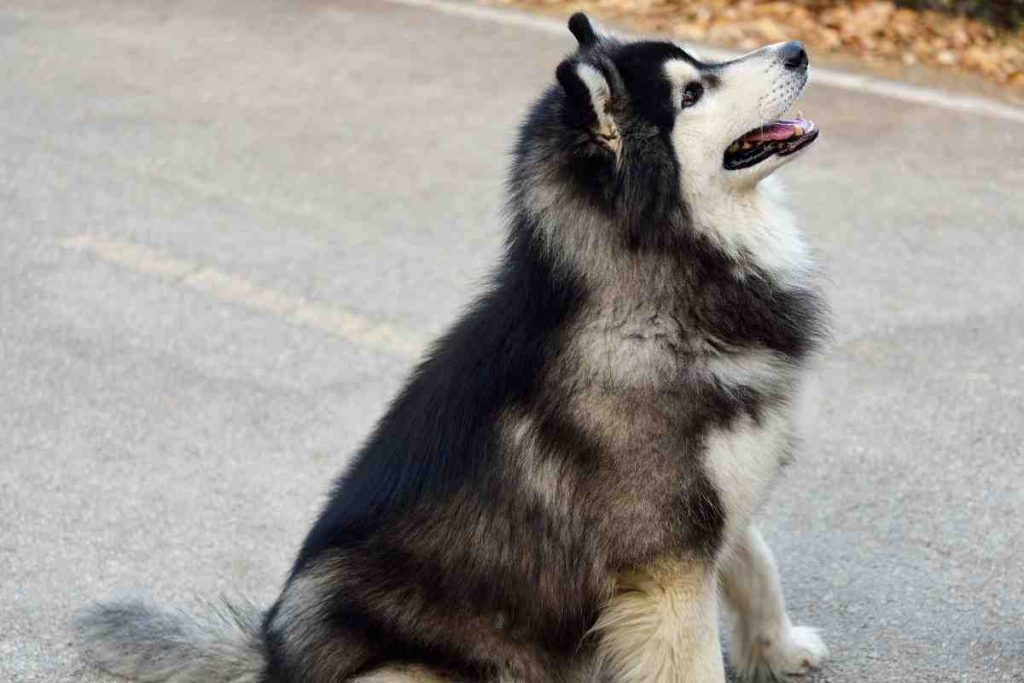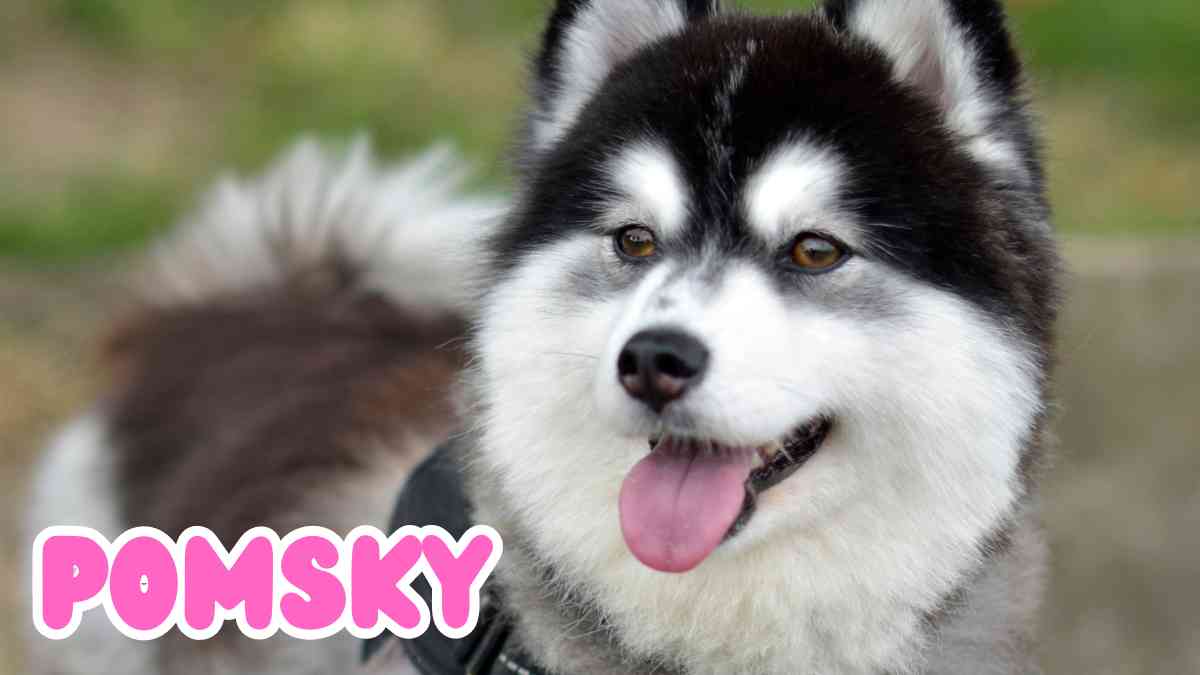Pomskies, the delightful crossbreed of Pomeranians and Huskies, have garnered attention for their undeniable charm. Discovering whether a Pomsky makes an ideal pet involves unraveling their unique characteristics and understanding the dynamics of their companionship.
Table of Contents
What is a Pomsky?
A Pomsky is a captivating hybrid breed, resulting from the crossbreeding of Pomeranians and Huskies. This intentional mix combines the endearing traits of the Pomeranian’s petite size with the majestic allure of the Husky. These designer dogs are carefully bred to maintain a balance in size, coat characteristics, and temperament.
Known for their striking appearance, Pomskies typically inherit the striking blue eyes of Huskies and the fluffy coat of Pomeranians. While variations exist, the breed generally exhibits a charming blend of both parent breeds.
Pomskies come in different sizes, including standard, mini, and toy, each influencing their suitability as family pets. As intelligent and energetic dogs, Pomskies require proper training and mental stimulation to thrive in a domestic setting.
Understanding the origins and defining features of Pomskies is crucial for anyone considering them as potential companions. Their unique blend of traits contributes to their appeal, making them an intriguing choice for those seeking a distinctive and lovable pet.

Size and Appearance
One of the most captivating aspects of Pomskies is their diverse range of sizes and striking appearances. The size of a Pomsky can vary, and understanding these variations is crucial for prospective owners.
Size:
Pomskies come in three main size categories standard, mini, and toy. The standard Pomsky usually weighs between 20 to 30 pounds and stands around 15 inches tall. Miniature Pomskies are smaller, weighing between 10 to 20 pounds and measuring around 12 inches in height. Toy Pomskies, the tiniest of the three, weigh approximately 5 to 10 pounds and stand about 10 inches tall. Choosing the right size depends on the living situation, available space, and the owner’s preferences.
Appearance:
The physical appearance of Pomskies is a delightful blend of their Pomeranian and Husky lineage. They often inherit the distinctive Husky markings, including masks, spectacles, and striking blue eyes. Their coats can vary in color and texture, with some displaying the thick, double coat of a Husky, while others showcase the fluffier, Pomeranian-style coat.
Despite these variations, Pomskies generally share a fox-like face, erect ears, and a plume-like tail, creating an irresistibly adorable and photogenic appearance. It’s essential for potential Pomsky owners to appreciate the range of sizes and appearances within the breed, ensuring they find a furry companion that aligns with their preferences and living circumstances.
Temperament and Personality
Understanding the temperament and personality of Pomskies is key to building a harmonious relationship with these charming hybrid dogs. Their characteristics are a unique blend of the Pomeranian’s vivacity and the Husky’s intelligence and independence.
Energetic and Intelligent:
Pomskies are known for their high energy levels and intelligence. Their playful nature makes them great companions for active individuals or families. Regular exercise and mental stimulation are essential to keep them content and prevent boredom-related behaviors.
Social and Affectionate:
Pomskies are generally social dogs that thrive on companionship. They form strong bonds with their owners and enjoy being part of family activities. Their affectionate nature makes them well-suited for families, and they often get along well with children and other pets when properly socialized from a young age.
Independent Thinkers:
Inherited from their Husky parentage, Pomskies can display an independent streak. While they are eager to please, they may also exhibit a touch of stubbornness. Consistent training with positive reinforcement is crucial to harness their intelligence and maintain a well-behaved companion.
Vocal and Expressive:
Pomskies may inherit the vocal tendencies of both parent breeds. They can be expressive with barks, howls, or “talkative” sounds. This makes them effective watchdogs, alerting owners to potential intruders or changes in their environment.
Adaptable to Living Conditions:
Pomskies can adapt to various living conditions, including apartments, as long as they receive adequate exercise and mental stimulation. However, potential owners should be prepared for the responsibility of meeting their energetic needs to ensure a happy and well-balanced pet.
Exercise and Training Needs
Pomskies, with their boundless energy and intelligence, require consistent exercise and training to thrive as happy and well-behaved pets.
Exercise Requirements:
Pomskies are energetic dogs that benefit from regular exercise to burn off excess energy and maintain a healthy weight. Daily walks, playtime, and interactive activities are essential to keep them physically and mentally stimulated. Engaging in activities like agility training or dog sports can be particularly enjoyable for Pomskies, tapping into their innate intelligence and agility.
Mental Stimulation:
Due to their intelligent nature, Pomskies thrive on mental stimulation. Puzzle toys, interactive games, and obedience training provide an excellent outlet for their mental energy. Incorporating training sessions into their routine not only keeps them mentally sharp but also strengthens the bond between the owner and the dog.
Consistent Training:
Training a Pomsky requires patience, consistency, and positive reinforcement. They respond well to reward-based training methods and may become stubborn if subjected to harsh or negative approaches. Basic commands, leash training, and socialization from an early age are crucial to mold them into well-behaved companions. Puppy training classes can be beneficial for both the owner and the Pomsky.
Socialization:
Early and ongoing socialization is vital for Pomskies. Exposing them to various environments, people, and other animals helps prevent shyness or aggression. Well-socialized Pomskies tend to be more adaptable and confident in different situations.
Interactive Playtime:
Pomskies love interactive play and thrive when given the opportunity to bond with their owners. Engaging in activities like fetch, tug-of-war, or providing them with stimulating toys helps satisfy their need for both physical activity and social interaction.
Owners should tailor their approach to exercise and training based on the individual needs and preferences of their Pomsky. Consistent routines, positive reinforcement, and a mix of physical and mental activities contribute to a happy, well-balanced, and well-behaved Pomsky companion.

Related Article : Are Lab Husky Mix Good Dogs?
Health Considerations
While Pomskies are generally robust, like any breed, they are prone to certain health considerations that prospective owners should be aware of to ensure their well-being.
Genetic Health Issues:
Pomskies may inherit health issues common to both Pomeranians and Huskies. These can include hip dysplasia, patellar luxation, and eye conditions. Responsible breeding practices and obtaining a Pomsky from reputable breeders who conduct health screenings can mitigate the risk of genetic health issues.
Weight Management:
Maintaining a healthy weight is crucial for Pomskies, especially given their smaller size. Obesity can exacerbate joint issues and lead to other health problems. A balanced diet and regular exercise are essential components of weight management for Pomskies.
Dental Health:
Pomskies, like many small breeds, can be prone to dental issues. Regular dental care, including brushing their teeth and providing dental chews, helps prevent periodontal disease and promotes overall oral health.
Vaccinations and Preventive Care:
Adhering to a regular veterinary schedule for vaccinations, flea and tick prevention, and heartworm medication is essential for Pomsky health. Regular check-ups with the vet allow for early detection of any potential health issues.
Weather Considerations:
Pomskies may have a thick double coat, inherited from their Husky parent, making them more suitable for colder climates. Owners in warmer climates should be mindful of the potential for heat-related issues and take precautions such as providing shade and ensuring access to cool water during hot weather.
Regular Exercise for Joint Health:
Given their energetic nature, Pomskies benefit from regular exercise, which not only supports their overall health but also helps with joint health. Activities like walks, play, and controlled exercise are essential for their well-being.
Pomsky as a Family Pet
The Pomsky, with its endearing personality and captivating appearance, can make an excellent addition to a family setting. Understanding the dynamics of having a Pomsky as a family pet is crucial for prospective owners.
Playful Companionship:
Pomskies are known for their playful and affectionate nature, making them wonderful companions for families with children. Their energy levels match well with the active playtime that children often enjoy, creating a dynamic and joyful atmosphere within the household.
Social Interaction:
These social dogs generally thrive in family settings where they can be part of daily activities. Pomskies form strong bonds with their owners and are often eager to engage in interactive play. Their sociable nature extends to getting along with other family pets when introduced and socialized appropriately.
Adaptability to Living Spaces:
Pomskies can adapt to various living spaces, including apartments, as long as their exercise and mental stimulation needs are met. Their smaller size, especially in the case of mini or toy Pomskies, makes them suitable for homes with limited space.
Child-Friendly Traits:
Pomskies, when properly socialized, tend to be patient and tolerant, making them well-suited for families with children. Teaching children how to interact gently with the dog and supervising their interactions ensures a positive and safe relationship.
Educational Opportunities:
Having a Pomsky as a family pet provides educational opportunities for children, teaching them about responsible pet ownership, empathy, and the importance of meeting a pet’s needs. Involving children in the care and training of the Pomsky fosters a sense of responsibility and respect for animals.
Watchful Nature:
Pomskies, with their alertness and vocal tendencies, can serve as effective watchdogs for the family. Their keen senses make them aware of changes in their environment, adding an extra layer of security to the household.
Pros and Cons of Owning a Pomsky
Considering the unique traits and characteristics of Pomskies is crucial for potential owners. Here’s a breakdown of the pros and cons associated with having a Pomsky as a pet.
Pros:
- Adorable Appearance: Pomskies boast a charming and photogenic appearance, combining the cuteness of Pomeranians with the striking features of Huskies.
- Playful and Energetic: Pomskies are known for their high energy levels, making them great playmates for active individuals or families. Their playful nature adds a joyful dynamic to the household.
- Intelligent and Trainable: With both Pomeranians and Huskies being intelligent breeds, Pomskies are generally quick learners. Positive reinforcement training can yield impressive results, making them well-behaved companions.
- Suitable for Various Living Spaces: Depending on their size (standard, mini, or toy), Pomskies can adapt to different living environments, including apartments, as long as they receive sufficient exercise and mental stimulation.
- Affectionate and Social: Pomskies form strong bonds with their owners and enjoy being part of family activities. Their affectionate nature makes them suitable for families and individuals seeking a loving companion.
Cons:
- Exercise Requirements: The high energy levels of Pomskies demand consistent exercise. Failing to meet their exercise needs can lead to boredom-related behaviors or excess energy, potentially causing issues.
- Grooming Needs: Pomskies often have thick double coats that require regular grooming to prevent matting and reduce shedding. This can be time-consuming, and owners should be prepared for regular brushing.
- Vocal Tendencies: Pomskies may inherit the vocal tendencies of both parent breeds, making them prone to barking or howling. While this can serve as an alert system, it may be undesirable in noise-sensitive environments.
- Independent Streak: Pomskies may exhibit some independence, inherited from their Husky parent. Consistent training and positive reinforcement are essential to manage any stubbornness and ensure good behavior.
- Potential Health Issues: Pomskies, like many designer breeds, can be prone to certain health issues inherited from their parent breeds. Responsible breeding practices and regular veterinary check-ups can mitigate these concerns.

Finding the Right Pomsky for You
Choosing the perfect Pomsky involves careful consideration of your lifestyle, preferences, and the specific traits of the individual dog. Here’s a guide to help you find the right Pomsky companion:
Research and Education:
Begin by researching the Pomsky breed thoroughly. Understand their size variations, grooming needs, exercise requirements, and potential health issues. Educate yourself on responsible breeding practices to ensure the health and well-being of your future pet.
Reputable Breeders:
Look for reputable Pomsky breeders who prioritize the health and temperament of their dogs. A responsible breeder conducts health screenings, provides proper care for the puppies, and is transparent about the breed’s characteristics. Avoid puppy mills or backyard breeders.
Visit the Breeder:
If possible, visit the breeder’s facility to meet the Pomsky puppies and their parents. Observe the living conditions, check for cleanliness, and ask questions about the puppy’s upbringing. Meeting the puppy’s parents can give insights into potential temperament and size.
Ask About Health Records:
Request health records for the Pomsky puppy, including vaccinations, deworming, and any genetic testing performed on the parents. A reputable breeder will provide comprehensive health information to ensure you are getting a healthy and well-cared-for puppy.
Meet the Puppy:
Interact with the Pomsky puppy you are considering. Observe its behavior, socialization skills, and how it interacts with you and others. A well-socialized puppy is more likely to adapt smoothly to its new home and family.
Consider Size and Energy Level:
Choose a Pomsky size (standard, mini, or toy) that aligns with your living space and lifestyle. Additionally, consider the energy level that matches your activity level. A high-energy Pomsky may be a great fit for an active individual or family, while a more laid-back temperament may suit those with a calmer lifestyle.
Ask About Training:
Inquire about the training the Pomsky has received before coming to your home. A puppy that has been introduced to basic commands and experiences positive reinforcement is likely to have a smoother transition into your household.
Evaluate Your Commitment:
Owning a Pomsky requires commitment in terms of time, energy, and financial responsibility. Ensure you are ready for the grooming needs, regular exercise, training sessions, and veterinary care that Pomskies demand.
How Much for Pomsky Puppies?
The cost of Pomsky puppies can vary widely based on several factors, including the breeder’s reputation, the lineage and pedigree of the parents, the puppy’s size (standard, mini, or toy), coat color, markings, and demand for the breed. On average, Pomsky puppies can range from $1,000 to $3,000 or more. However, it’s important to note that prices can go even higher, especially for puppies from well-known and reputable breeders.
Here are some key factors that influence the price of Pomsky puppies:
- Breeder Reputation: Reputable breeders who prioritize the health, well-being, and proper breeding practices often charge higher prices for their puppies.
- Pedigree and Lineage: Pomskies from parents with exceptional pedigrees or those descended from champion lines may be priced higher.
- Size and Color: The size of the Pomsky (standard, mini, or toy) and specific coat colors or markings can influence the price. Certain coat colors or unique markings may be more sought after.
- Geographical Location: Prices can vary based on the region or country. Pomskies may be more expensive in areas where there is higher demand for the breed.
- Included Services: Some breeders include services like vaccinations, health checks, microchipping, and spaying/neutering in the puppy’s price.
When considering purchasing a Pomsky, it’s crucial to do thorough research on breeders, ensuring they follow ethical practices and prioritize the health and well-being of the puppies. Avoid deals that seem too good to be true, as they may indicate poor breeding conditions or potential health issues. Additionally, budget for ongoing expenses such as grooming, training, and veterinary care once you bring your Pomsky home.
Conclusion
In conclusion, choosing a Pomsky as a pet is a delightful venture for those seeking a charming, playful, and affectionate companion. Understanding the unique characteristics, considering size and energy levels, and selecting a reputable breeder are crucial steps in finding the perfect Pomsky for your lifestyle.
While the cost varies, investing in a well-bred and healthy puppy ensures a rewarding and lasting bond. With their adorable appearance and lively personality, Pomskies have the potential to bring immense joy to families and individuals alike, creating a loving connection that lasts a lifetime.
You May Also Like:




Leave a Reply